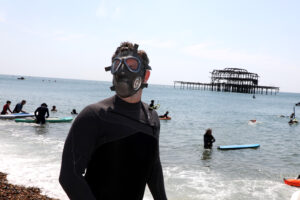Quick question: How can hotels cut water use with eco-feedback?
Dr Pablo Pereira-Doel is a lecturer in Hospitality Information Technology at the School of Hospitality and Tourism Management and the Water Literacy and Sustainable Water Behaviour Area Lead at the Institute for Sustainability, University of Surrey. He environmental challenges facing the sector, and has partnered with some of the leading names in the industry to help bring footprints down.
Water use is one of the most pressing issues, with the average hotel getting through between 100 and 200 gallons of fresh water each day. In a bid to help bring this down, consumer and industry testing research has contributed to the development of smart water-saving technology which ‘nudges’ users towards taking shorter showers.
Known as ‘eco-feedback’, Dr. Pereira-Doel has introduced this innovation to hospitality and travel giants including Scandic, Hilton Hotels & Resorts, TUI, Hostelling International, Radisson. Not to mention some of the biggest names in water, cosmetics, beauty and more – from Anglian Water to L’Oréal R&I. Keen to learn more, we asked him some quick questions about how this idea works.
What is eco-feedback?
Eco-feedback is a behavioural strategy to increase people’s awareness of the natural resources they use with the aim of reducing their environmental impact.
Eco-feedback has been studied for over 50 years predominantly in energy behaviour. As our cognitive resources are typically limited, we often bquehave in autopilot, especially with routine behaviours.
By informing individuals about their own performance, we bring awareness that can potentially foster positive changes. Thus, eco-feedback involves providing information on environment-related behaviours.
The initial step for eco-feedback to be effective is to capture the individual’s attention without provoking rejection or defensive reaction. After that, the eco-feedback effectiveness relies on its informational and motivational properties to close the gap between the feedback and the individual’s behaviour/performance. Other factors affect the effectiveness: the task itself, the context, and the individual’s inherent characteristics.
How can this be used to help reduce water use in the hotel industry?
One of the highest water consumption behaviours in tourist accommodations is showering. Moreover, we usually take hot showers, requiring high amounts of energy to heat the water, resulting in carbon emissions. So, showering is a type of high impact behaviour that could bring other environmental benefits beyond water conservation.
Tourist accommodations represent a great context to break certain routine behaviours such as showering. Those behaviours, performed in autopilot mode, are disrupted in a new context, such as a different shower cubicle in a tourist accommodation.
In addition, our eco-feedback is provided through a smart device installed in the shower cubicle, representing a novel element in that context and thus, helping to capture individual’s attention towards the feedback itself. Moreover, the continuous and real-time nature of that eco-feedback nudges individual’s attention while they perform the behaviour.
How much of a problem is water use in the hotel industry?
Over a third of the global population resides in areas with high water stress levels, many of which are popular tourist destinations. For instance, Barcelona welcomed last year almost 16 million visitors, with many of them staying in tourist accommodations. However, in February, Barcelona declared a drought emergency. Despite this, visitors are expected to continue arriving, especially during peak summer when water scarcity is most acute.
The challenge lies in the heavily reliance of the hotel industry on the artificial population, those visiting the destination, increasing stress on already scarce water resources.
Moreover, tourist accommodations use up to 250 more litres of water per person per day compared to homes, attributed to daily cleaning, laundry, kitchens, bathrooms, swimming pools, gardens, and more. The more luxurious the accommodation is, the higher its water consumption.
In such circumstances, relying solely on innovators or early adopters of water-saving solutions to reduce water consumption is insufficient. We need the majority to lead by doing. By doing so, we can mitigate potential conflicts between residents and visitors.
What are the limitations to rolling out eco-feedback in hotels?
Through our research, we co-developed an innovative solution aimed at reducing water consumption during showers. Data from over 17,000 showering events across six tourist accommodations showed that our continuous real-time eco-feedback solution reduced showering duration by 25.79%. Remarkably, guests were not influenced by financial incentives or peer pressure to conserve water or energy.
Now, our first challenge lies in effectively disseminating these academic findings to those responsible for implementing them in real-world settings. Secondly, some tourist accommodations might be concerned about potentially affecting the customer experience.
However, our experiments in tourist accommodations have shown no evidence to support this fear. Furthermore, we have demonstrated that guests are willing to conserve water when accommodations provide the necessary enabling technology and support.
More on waste and recycling:
NGOs, opposition and businesses cast doubt over UK Government waste plans
Quick question: how can we monitor outdoor water quality with FreeUP?
Image: Victor Furtuna















